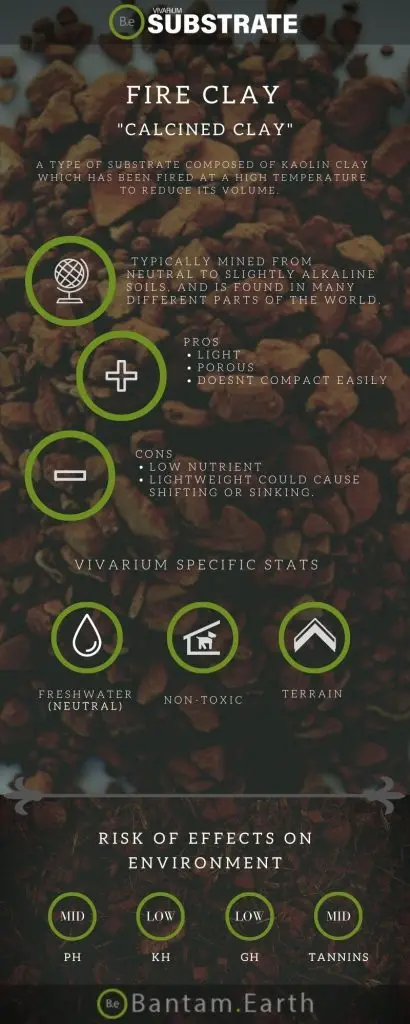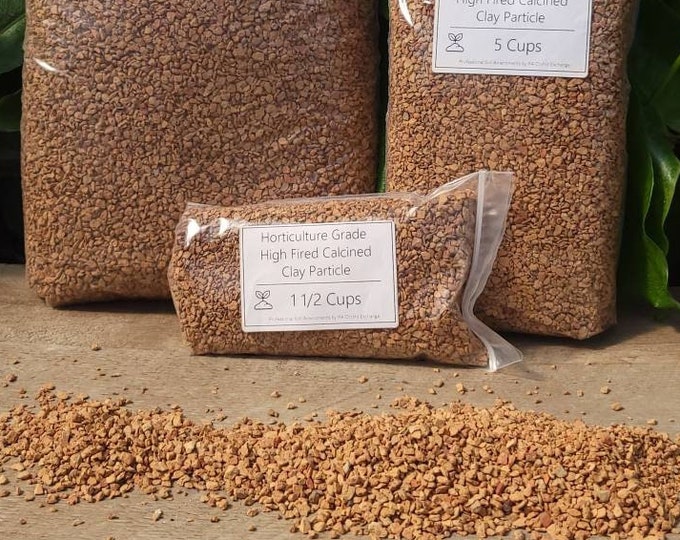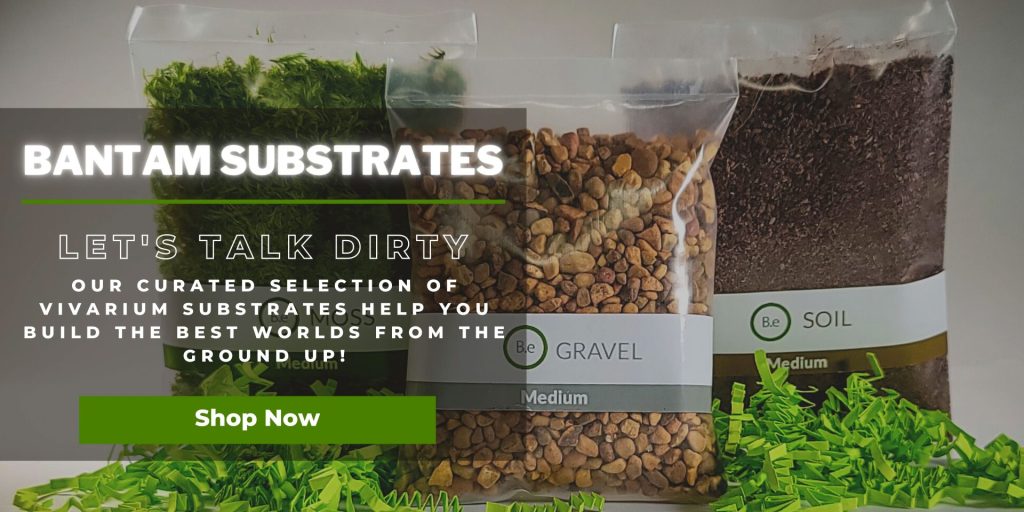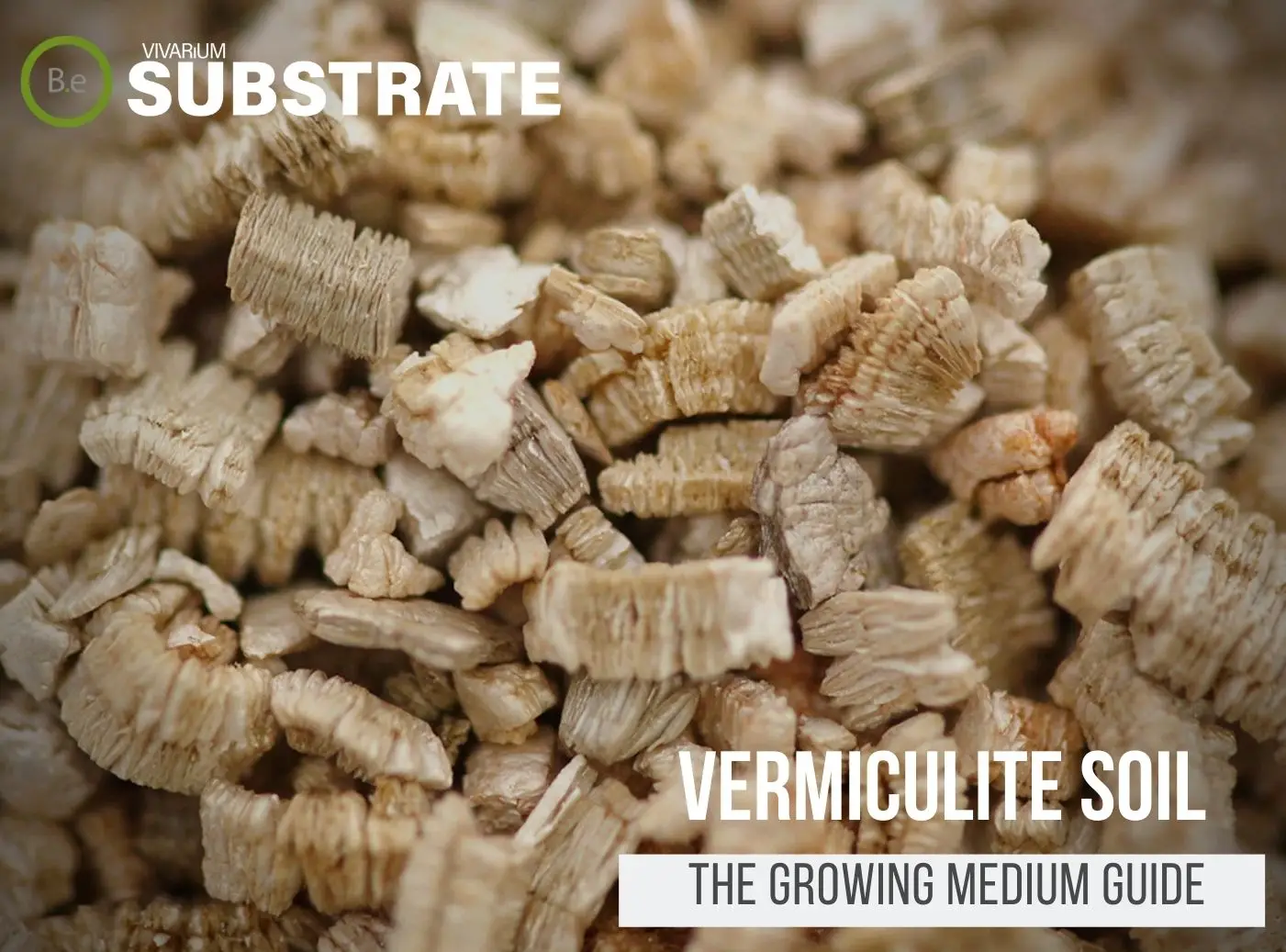If you’re looking for a lightweight, low-cost substrate that is easy to prepare, look no further than calcined clay.
This unique substrate is gaining popularity as both aquarium soil and terrarium soil alike for its abundance of benefits.
From allowing roots to breathe to supporting friendly pathogens that help plants grow this clay has many perks.
In this guide, we’ll explore what calcined clay is, its characteristics, habitat, environmental influence, and its usage in various kinds of vivariums.
Table Of Contents:
ToggleWhat Is Calcined Clay?
Calcined clay is a type of substrate composed of kaolin clay which has been fired at a high temperature to reduce its volume.
This clay is light, porous, relatively dust-free, and doesn’t compact easily.
Commonly known as Turface, it is widely used in vivariums for its unique properties and its ability to retain moisture for longer periods of time.


Calcined Clay Facts
Calcined clay is widely available around the world and is most commonly formed through the mining of minerals.
After mining this clay-like material, it is then heated at a high temperature to reduce its size and expand its surface area.
This process is also known as baking and turns the clay vessels into a light, porous material that is capable of retaining moisture and supporting plant growth.
Description
Turface is an incredibly light and porous substrate material.
Depending on the size, it can range in color from white to gray with a few shades in between.
In addition to its lightness and porosity, this substrate material also has an incredibly high absorption rate.
It also resists compaction, making it a great choice for vivariums with burrowing creatures.
Habitat
Calcined clay is typically mined from neutral to slightly alkaline soils, and is found in many different parts of the world.
It is widely available in powder form, but can also be found in compressed blocks for easy transport and storage.
Environmental Influence
Turface does not have a significant impact on the pH level of a vivarium, as it is naturally non-acidic and neutral.
This is great for plants and animals, as it allows them to thrive without the risk of any nutrient deficiencies.
It also resists compaction, which reduces the risk of root rot due to excess moisture.
Vivarium Type
Calcined clay is suitable for use in many different types of vivariums.
It can be used as a top layer in terrariums, which will help retain moisture and reduce evaporation.
In forest or jungle vivariums, this clay can be used as a groundwater or water table layer.
Furthermore, Turface makes a great soil amendment to keep the soil loose and light.
This substrate material can also be used as a functional, standalone substrate in aquariums.
- Paludariums – Half aquatic/ half terrain-based enclosure.
- Terrariums – Fully terrain-based enclosures with little to no aquatic features.
- Aquariums – Fully aquatic-based enclosures with little to no terrain features.
Vivarium Usage
Calcined clay can be used in many ways in a vivarium.
At its most basic level, it can be used as an inch-deep layer of substrate, to support moisture retention and microbial growth.
It can also be used as a middle layer to help retain moisture and provide air pockets for roots.
As a top layer, it can be used to reduce evaporation and help protect against the sun.
Advantages
Calcined clay is one of the lightest possible substrate materials available, making it ideal for vivariums with burrowing creatures.
Its porous nature allows oxygen and water to penetrate easily and helps reduce the risk of anaerobic conditions.
In addition, it is an economical substrate that is easy to prepare and can be used in many different ways.
Disadvantages
Although calcined clay has many advantages, there are also some drawbacks.
Its lightness can make it unreliable in holding too much weight, which may cause it to sink or shift in certain environments.
It also has a very low nutrient content, so it is best used as a soil amendment rather than a standalone substrate.
Buy Calcined Clay
Calcined clay is widely available from many online retailers and gardening stores.
Make sure to purchase from a reliable source to ensure quality and safety, as some cheaper clay products may contain impurities.
Click the image below to find out more about the current price and other relative information:


Calcined Clay Preparation & Tips
When preparing a turface for use in an enclosure, make sure to follow these tips for the best results.
First, make sure to wear a dust mask and goggles when handling this substrate, as it will create a great deal of dust when handled.
Next, soak the clay in water for at least six hours before using it to help ensure a light and even consistency.
And finally, when using calcined clay as a soil amendment, make sure to mix it with other additives, such as fine sand or peat moss, to add nutrients and adjust the pH.
Calcined Clay Substitutes
If calcined clay isn’t the right choice for your vivarium, there are a few alternatives that you may want to consider.
Volcanic clay, expanded clay, and pumice are all lightweight substrates that can help retain moisture and provide aeration in a very similar way.
Conclusion
Calcined clay is a lightweight, non-acidic substrate with many advantages in aquariums and terrariums.
It is easy to prepare, reduces the risk of root rot, and is ideal for burrowing creatures.
It also doesn’t contain many nutrients, so it is better to be used as a soil amendment for terrariums and a standalone aquarium substrate.
If you’re looking for a lightweight substrate that will help retain moisture in your vivarium, turface is a good choice.
Frequently Asked Questions
Yes, calcined clay is an excellent soil amendment for plants. Not only does it help hold in moisture and improve drainage, it also raises the pH level in the soil. Additionally, calcined clay contains an abundance of essential nutrients and minerals that can help plants to flourish.
Calcined Clay, also known as calcined kaolin, is widely used in soil to improve physical and chemical properties such as moisture and cation exchange capacity, particle size distribution and permeability. It also helps to buffer soil pH, reduce compaction, and improve drainage. Additionally, it can help to increase the soil‘s ability to hold nutrients, regulate water availability, reduce leaching, and provide a good environment for beneficial microbial activities.
Yes, calcined clay is an excellent soil amendment for succulents! When used in a potting mix, it helps promote drainage, aeration, and overall soil structure. It also provides numerous micronutrients for succulents to thrive and reduces the chances of root rot. Make sure to look for a specially formulated potting mix for succulents or create your own blend that includes calcined clay!
Calcined clay is created by heating raw clay to a high temperature until it becomes inert, creating a material with a wide range of uses. To make calcined clay, begin by selecting a type of clay. Consider the properties of the clay and its intended uses. Next, place the clay in a kiln and slowly heat to temperatures between 1000°C and 1300°C (1800°F to 2300°F). Remember to open the exhaust vent intermittently to release smoke and other noxious fumes. Finally, store the calcined clay in a container with a tight seal to keep it from picking up moisture from the air.
No, calcined clay and Akadama are not the same. Calcined clay is a type of substrate that is composed of an organic material that has been heat-treated and then crushed into granules. Akadama is a type of soil used in Japanese bonsai cultivation that is formed from clay particles and organic matter but is not heat treated.
No, calcined clay is not toxic. Although its production process involves heating up clay to extremely high temperatures, calcined clay is a safe and non–toxic substance. It is used as an ingredient in many products, including pottery, ceramics, and fertilizers.







